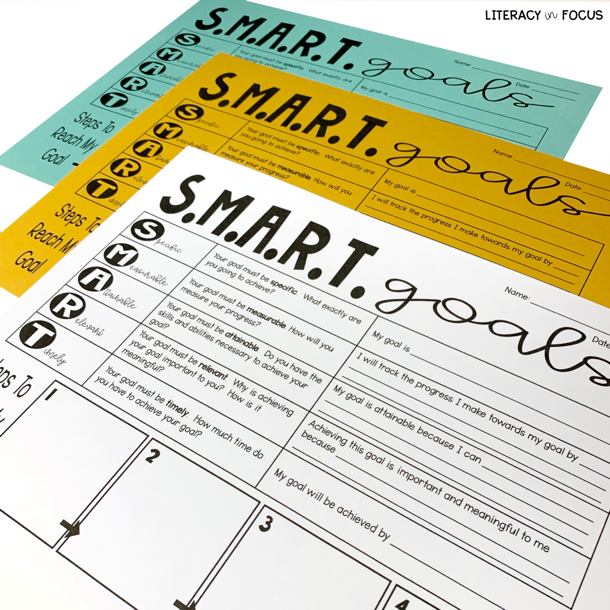Brooklyn shares an interactive step-by-step lesson plan for supporting your students to set SMART goals, and includes a template. January is an ideal month to reflect on how students have grown throughout the year, and to set goals for the next few months.

Setting goals is a valuable skill that can be taught to most levels of learners. Taking the time to teach students the skills required for effective goal setting will provide them with the tools necessary for reaching their full potential. The month of January is a perfect time to implement a quick and engaging lesson on how to successfully set S.M.A.R.T. goals.
Start the lesson by having students write down one goal. Make sure you don't give them any parameters. After students have written down their goal, show them the sobering statistics. According to U.S. News, 80% of New Year's resolutions fail by February! Give students a moment to brainstorm why this is the case. Next, explain the power behind setting S.M.A.R.T. goals. You can find talking points and examples in this article, S.M.A.R.T. Goals: How To Make Your Goals Achievable. Emphasize to your students that, setting S.M.A.R.T. goals allows you to clarify your ideas, focus your efforts, use your time wisely, and increasing the changes of what you set out to achieve.
Specific
Have all students stand up. As you go through each letter of the S.M.A.R.T. goals acronym, have students sit down when their goal does not meet the exact criteria. Begin with S (specific). Ask students if their goal is specific. Is it fine-tuned, and do they really understand what they are trying to achieve? Use running as an example. Setting a goal to become a better runner is vague, but setting a goal to run a mile within a certain amount of time is specific. Have students sit if the goal they wrote down is not specific.

Brooklyn's S.M.A.R.T. Goal Setting Worksheet
Measurable
Move on to M (measurable). Let students know that their goals must be measurable. How will they know that they have achieved their goal? Are there benchmarks they can hit along the way? For example, running a faster mile is specific, but not measurable. Indicators of progress toward a faster mile might mean decreasing the time in ten-second increments. Have students sit down if their goal is not measurable.
Attainable
The next letter in the S.M.A.R.T. goals acronym is A (attainable). An attainable goal is something that can be achieved with current skills and abilities. Continue to use the running goal as an example. If the goal setter does not currently have the ability to run a complete mile, improving the mile time is not an achievable goal. Another great example of this is the goal to become a professional athlete. While a valid dream or ambition, it is not a S.M.A.R.T. goal because the student does not currently possess the skill and ability required of a professional athlete. Have students sit down if their goal is not attainable.
Relevant
The R in S.M.A.R.T. goals stands for relevant. If a goal is relevant, it is meaningful and important. Go back to the running goal example. Why is it important for the runner to improve their mile time by twenty seconds? Maybe they are trying to make the track team or get a better grade in gym class. Either way, the goal has importance. Have students sit down if their goal is not meaningful.
"...setting S.M.A.R.T. goals allows you to clarify your ideas, focus your efforts, use your time wisely, and increasing the changes of what you set out to achieve."
Timely
Last, the T stands for timely. It is critical that the goal has time constraints. There is no urgency created by an open-ended goal. For example, the runner will decrease his or her mile time by twenty seconds within six months. Putting a sixth-month deadline on the goal will create a sense of urgency. If any remaining students are still standing, have them sit down if their goal is not timely.
Looking around the classroom, it will become apparent that everyone needs to revise their goal. Read through these inspiring quotes with your class to give students ideas. Additionally, streamline the goal-setting process with your students by using a goal setting worksheet. Your worksheet should clearly explain each letter of the S.M.A.R.T. goal setting acronym and includes sentence starters for students to complete. You should also include space to record action steps is also included.
Here is Brooklyn’s S.M.A.R.T. Goal Setting Template and additional resources to support students to set goals: Setting S.M.A.R.T Goals Student Worksheet and My Personal Goals Worksheet.
Share how you teach S.M.A.R.T. goals to your students with us on Instagram, Facebook, Twitter, Pinterest, and Google+.
Author Bio:
Brooklyn Khan holds a secondary teaching credential in Language Arts and Social Science as well as a Master’s Degree in Education. She has more than ten years of teaching experience working with learners of all levels and abilities. Brooklyn creates meaningful content and material for teachers all over the world at www.litinfocus.com. You can connect with her on Facebook, Instagram, and Pinterest @Literacyinfocus.










